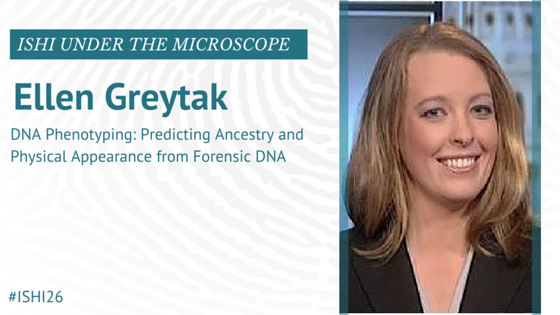The ISHI 26 agenda is already filling up with some great talks from amazing speakers! While the forensic community is a tight-knit group, we can always get a little closer, right? With that in mind, we asked our speakers some questions to get to know them a little better outside of their work. We’ll be posting their responses over the coming months in a feature we like to call Under the Microscope.
Today, we’re chatting with Ellen Greytak, who will be presenting DNA Phenotyping: Predicting Ancestry and Physical Appearance from Forensic DNA during the General Sessions.
Dr. Ellen Greytak is the Director of Bioinformatics at Parabon NanoLabs, Inc. She holds a PhD in Evolutionary Biology from Harvard University and has nearly 10 years of experience studying the genetics of human traits. For the past 2.5 years, she has served as the scientific lead for the Snapshot™ Forensic DNA Phenotyping system, among other projects.
How did you come to work in the field of forensics/DNA?
I studied human evolution and population genetics for my PhD, trying to understand how human genetics and population history explain physical traits. In my postdoc, I worked on whole-genome sequencing data and learned programming skills to create my own analyses and workflows. This put me in a great position to do the research and tool development required for building a new DNA phenotyping system. We’re also using the analyses I’ve developed for medical research.
If you woke up tomorrow and this field no longer existed, what would you choose for a career?
I would still work on understanding human genetic traits, just different ones!
What new technologies are you most excited about or where do you see the field heading in the next 10 years?
I am excited to see the new capabilities that next-generation sequencing can bring to the field. It’s revolutionized medicine, and I’d love to see those advances implemented in forensics.
What person would you say has had the biggest influence in your life?
Although I’ve never met them, Rebecca Cann, Mark Stoneking, and Allan Wilson, who wrote the initial 1987 paper using the mitochondrial genome to understand human evolution. When I read that paper as a sophomore in college, I immediately knew that’s what I wanted to study for the rest of my life.
Can you think of a specific example where ISHI has helped you in your career or with a case?
ISHI was the first forensics conference I ever attended, and it really opened my eyes to the unique issues faced by the field. Having only previously worked with clinical samples, I learned about mixed samples, partial profiles, DNA degradation, etc. and also had an opportunity to hear all about the exciting research going on in forensic DNA analysis. I think we would have been a lot further behind in our understanding of forensics if we hadn’t come to ISHI.
Who in the audience would benefit most from your talk?
Scientists interested in how genetics can be used to make trait predictions, lab personnel curious about new advancements in forensic DNA technology, and investigators wondering what new information can be obtained from DNA samples.
If you won the lottery, what would you do with the winnings?
Travel to ultimate frisbee tournaments around the world!
If you were to have a theme song, what would it be?
Stronger by Kanye West
Would would your ideal vacation be?
Sailing, snorkeling, hiking, and lying in the sun with a good book.
WOULD YOU LIKE TO SEE MORE ARTICLES LIKE THIS? SUBSCRIBE TO THE ISHI BLOG BELOW!


